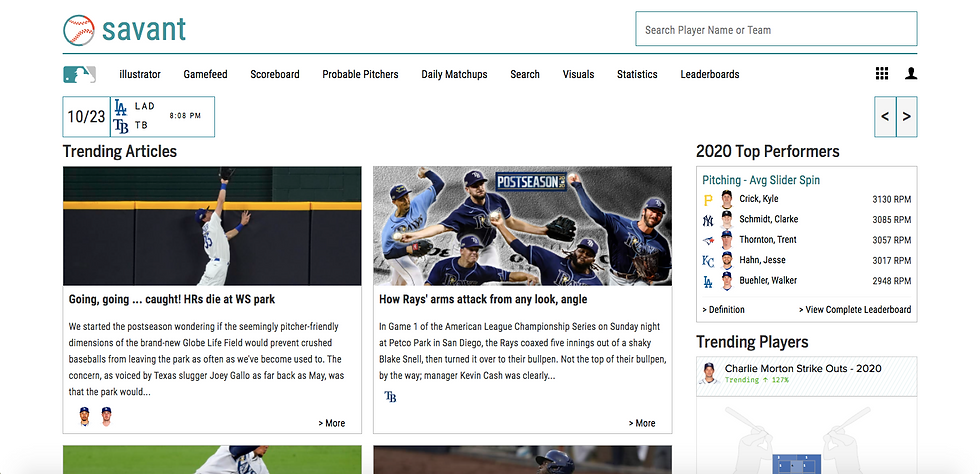Data Visualization Chunk 2
- tombond912
- Nov 3, 2020
- 3 min read
Last week I wrote a blog post on how I visualized data from a website Baseball Savant. I choose this website due to my interest in baseball and how analytics are used to scout and evaluate players. More recently, analytics are know for its use during games for strategy/game planning.

As mentioned in my last post, I decided to focus on the statistics of MLB Team Hitting regarding a specific a group of statistics. The reason for choosing the statistics I did was because of the story they can tell about a team's offensive ability. It was clear when I demonstrated that using Hard Hit % and Runs Scored.

The top 3 teams in Hard Hit, were consequently top 3 in runs scored. The correlation clearly marks a statistical significance of the statistic. This week I was tasked with using Data wrapper to visualize the same data set. When I first interacted with DataWrapper I was impressed with the flexibility it provided. The website first asked me to enter my entire data set in its raw form into a text box, I was unsure if it would be able to organize it and needless to say I was wrong.

Data Wrapper easily formulated my data into the table above. I did have to make a few changes which included deleting the 'Logo Column'. I did this because the pictures in my original chart were not able to transfer. Additionally, to better visualize my data, I choose to change the data from the categories of "WOBA, xWOBA, WOBACON, xWOBACON" from a decimal to a whole number. I did this because the chart's were basing the numbers off of the X - Y Axis with Maximum's and Minimum much higher than the decimals. It made the statistics appear insignificant.

This picture represents all of the choices that I was given for how to evaluate my data set. I was able to easily sift through which visualization tool would best represent my graph. I decided to choose Split Bar Chart.
Along with the picture above, my chart may also be found here.
I felt this would be the best way to visualize my data and certainly an more attractive way when compared to my table in my post last week.
When analyzing my data, a question I asked myself is what similarities and difference the top 2 teams, Dodgers and Rays, have. The obvious reason for my interest was that they most recently played against each other in the World Series. To help me isolate both teams, Data Wrapper made it easy by highlighting what data I wanted to focus on specifically. After highlighting the Rays and Dodgers, my chart looked like this.

Right off the bat, it is easy to see the Dodgers lead the Rays slightly or more in nearly every category with exception to WOBACON. As an individual who followed the postseason, Rays were a team that relied heavily on hitting the long ball as opposed to stringing hits together. WOBACON is severely boosted by homeruns and is not necessarily penalized by strikeouts since the statistic only focuses on balls put in play. Dodgers, on the other hand, were very balanced and had the ability to walk, and string more hits quite often. This is clearly depicted through the Dodgers high numbers in each category. The Rays having a high WOBACON but lower Runs Scored total can demonstrate that when they hit the ball hard, there are more frequently less players on base. These statistics came to life in the World Series when the Dodgers defeated the Rays in 6 games, 4-2. Rays, no surprise to the numbers, struggled to generate runs in their 4 losses when it wasn't by the homeruns. While the Dodgers offense consistently put pressure on Rays pitching through generating walks and consistent base hits mixed in with their own flurry of homeruns.
In conclusion for the data set, it is extremely important to hit the ball hard. But if you want to be on top, limiting strikeouts, increasing walks will be the route to get you there.
Thanks for reading!!


Tom,
I am really intrigued by both these data and your analysis.
One thing I am curious about is whether there is a specific definition of "hard hitters."
Hey Tom! This is a really cool topic to pick! I really enjoyed reading your post and I had pretty much the same struggles with playing around with Data Wrapper. Overall pretty easy to use once you figure it out, and super helpful that there are so many options of visuals for your work- looking forward to hearing more about this on zoom tonight!